Verdict
The Asus ROG Zephyrus Duo combines record-breaking speed with a great pair of screens, making it an exceptional option for top-line gaming and creative work. But, ergonomic compromises mean you should only buy this laptop if you appreciate its unique features.
Pros
- The world’s fastest laptop processor from AMD
- Incredible Nvidia graphics power
- Dual-screen design provides quality and versatility
- Reasonable connectivity and build quality
Cons
- Dual screens mean poor ergonomics
- Heavier and thicker than some rivals
- No Thunderbolt and no SD card reader
- Pricier than some competitors
Availability
- UKRRP: £4599
- USARRP: $3999
- EuropeRRP: €5599
Introduction
Some companies aren’t shy about pushing design boundaries, and the dual-screen ROG Zephyrus Duo is another head-turner from Asus.
This is the kind of innovation people will appreciate, and it’s not just about games. Asus reckons it’ll prove popular with streamers and creatives who want more space for timelines and communication tools.
There’s no power shortage, thanks to an Nvidia GeForce RTX 4090 and flagship AMD processor. But, there’s no shortage of high prices here either, with this range-topping Zephyrus (GX650PY-NM010W) costing $3999/£4599/€5599.
Asus rigs like the Strix Scar 16 have already arrived, the MSI Titan GT77 is a powerhouse, and forthcoming Alienware and Razer laptops will aim for our best gaming laptops guide.
Design and Keyboard
- Often uncomfortable to use
- Decent connectivity, but no Thunderbolt
- Heavier and thicker than many rivals
Unsurprisingly, the second display – dubbed the ScreenPad Plus – dominates every aspect of the Duo. Open the lid and a mechanism lifts the ScreenPad to an angle of thirteen degrees, which improves cooling and viewing angles.
It looks cool and futuristic. There’s an iridescent slash on the lid and RGB-filled glass between the ScreenPad and keyboard that add to the vibe.
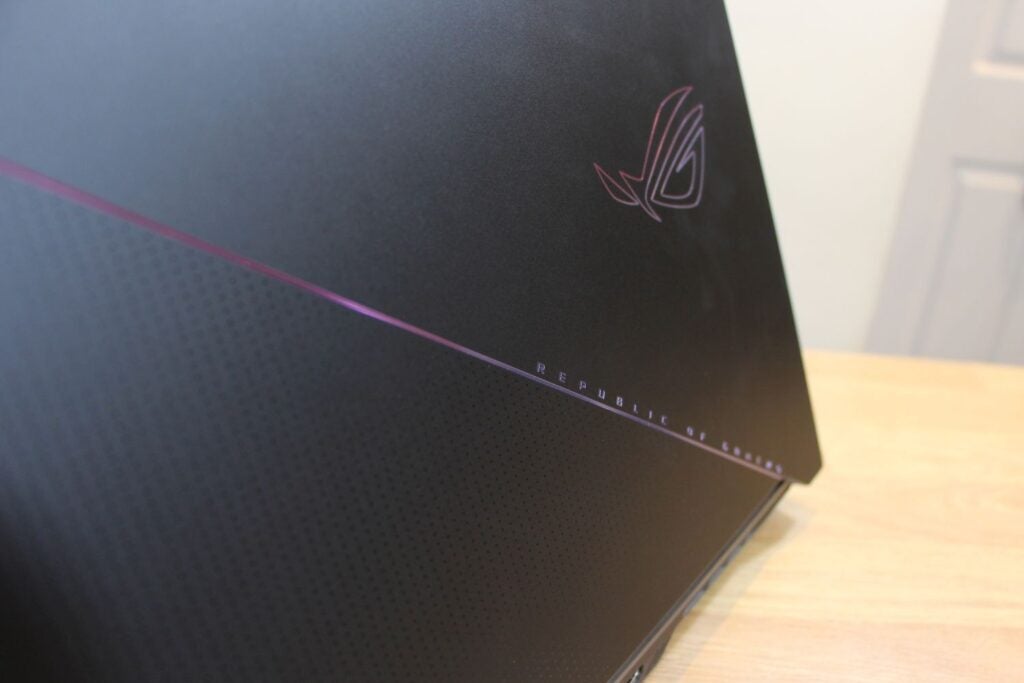
Build quality is consistently excellent, and the screen mechanisms work smoothly. You’ll only want extra protection for this laptop to protect its looks.
At 2.7kg in weight, 30mm thick and 266mm deep, it’s heavier than the Asus ROG Strix Scar 16 and Zephyrus M16 and larger than the forthcoming Razer Blade 16. The MSI Titan GT77 and Alienware m16 are even bigger, though.
The second screen doesn’t just add bulk, its inclusion forces the keyboard to the front of the notebook and makes the layout cramped. There’s a single-height Return key, small cursor buttons and no number pad. There’s no wristrest, and Asus’s rubberized version doesn’t attach to the laptop, so it’s easy to knock out of position.
The trackpad has an awkward number pad overlay, and the pad is extremely narrow. It’s not intuitive for gaming or creative work.
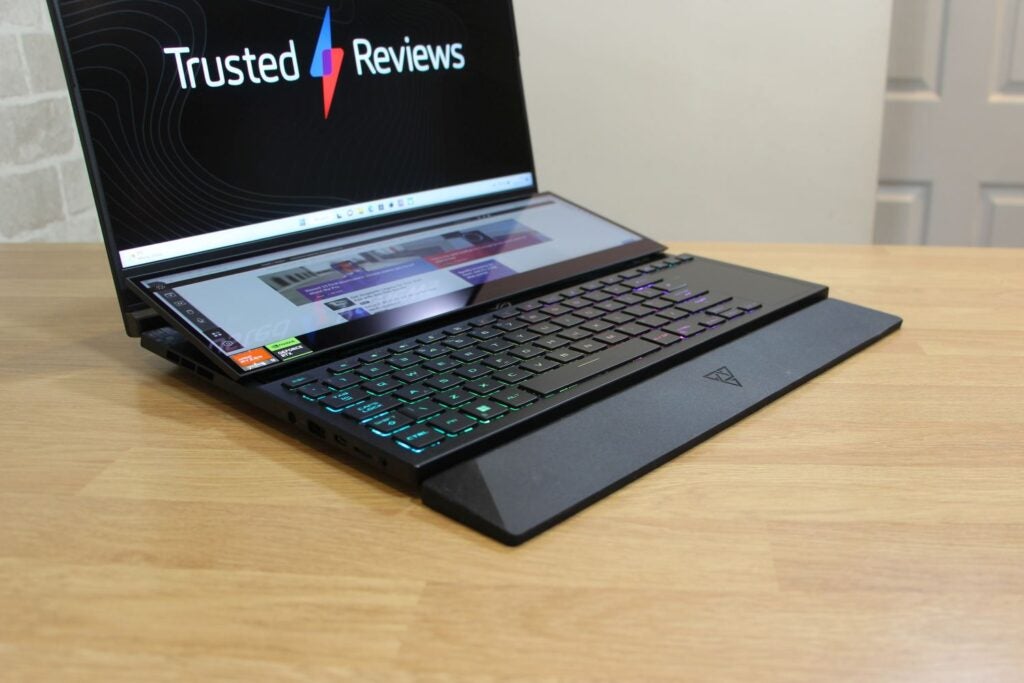
It’s a shame, because the keyboard offers good quality, with per-key RGB LED lighting, 1.7mm of travel and a snappy, consistent typing action that’s great for work and games. You’ll only get a better feel by opting for a mechanical alternative, like the MSI Titan GT77 or the Alienware’s optional CherryMX upgrade. It’s just a shame that everything’s so squeezed.
The Asus has two USB 3.2 Gen 2 ports and two USB-C connectors with DisplayPort and power delivery. It’s also got an HDMI 2.1 port and a microSD card slot. Internally, there’s 2.5Gbps Ethernet, Wi-Fi 6E and Bluetooth 5.3.
Unfortunately, the rig’s AMD processor means no Thunderbolt, and there’s no full-size card reader. Razer and Alienware laptops offer the latter, and you’ll find Thunderbolt on everything with an Intel CPU.
The Duo has a 1080p Windows Hello webcam but doesn’t have a privacy shutter. There’s no fingerprint reader. The Duo offers pairs of M.2 and memory slots, but getting inside the laptop is extremely difficult.
Screen
- Market-leading, high-resolution Mini LED
- Second screen is an ideal home for secondary apps
- Punchy and clear speakers
The main panel of the Asus ROG Zephyrus Duo 16 is a 16:10 Mini LED display with a 2560 x 1600 resolution. Asus claims a maximum brightness of 1,100 nits, and the screen has 1,024 dimming zones. The 240Hz refresh rate and 3ms response time will satisfy most gamers.
The ScreenPad is a 14 inch panel with a 3840 x 1100 resolution designed to retain size and clarity when apps move between the displays. It’s not Mini LED, but it’s a Gorilla Glass touchscreen with stylus support and IPS technology.
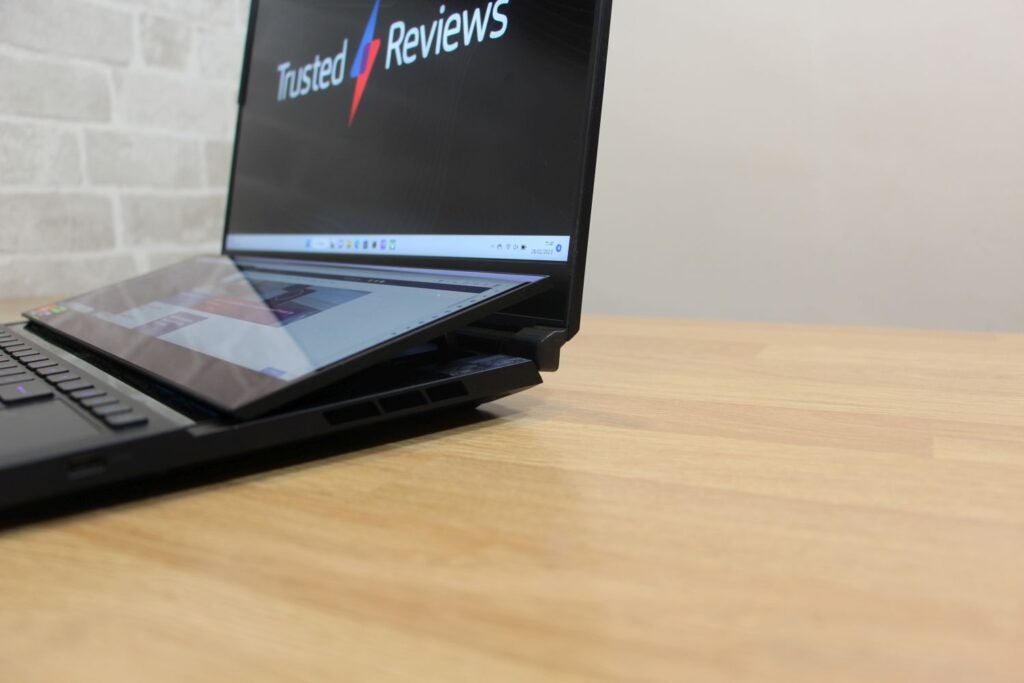
That secondary screen is ideal for streamers and gamers who need space for comms and configuration tools as well as creatives who need room for timelines or extra apps. It’s not for everyone, but it’s a useful addition.
It’s easy to use, too. The Asus Screen Xpert app allows users to create custom layouts and groups of apps, and the Asus Control Center has dedicated dials and buttons for Adobe’s creative apps.
The main display is brilliant. In HDR mode, the panel attains a 1,047-nit brightness level. Its dimming zones deliver genuine punch and nuance in HDR content. In SDR mode, it tops out at a mighty 752 nits. The low black point of 0.05 nits means contrast levels of about 15,000:1, so you get stunning vibrancy and punch in any gaming or creative app.
The Delta E of 1.52 means accurate colours, and the screen produced 99.9% of the sRGB gamut and 98.5% of the DCI-P3 space – so it’ll handle any game or media situation. A minor issue is the Adobe RGB coverage level of 89.2%, which isn’t quite high enough for demanding creatives.
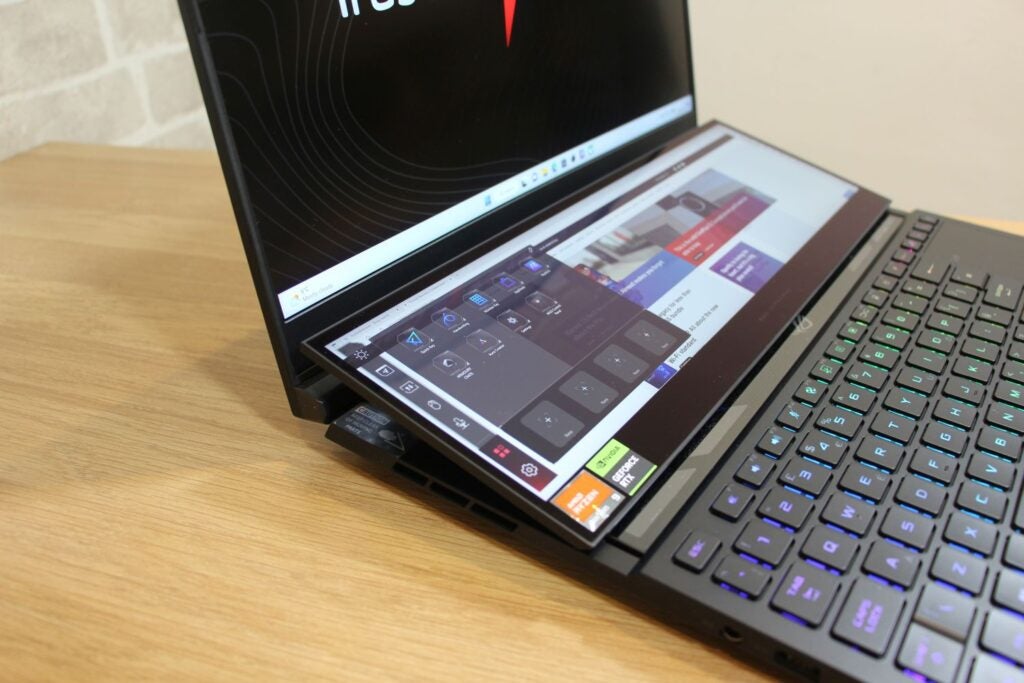
The ScreenPad’s maximum brightness of 397 nits is alright for indoor use and it displayed 96.2% of the sRGB space with a Delta E of 1.8. It’s fine, even if it doesn’t have the breadth for creative work.
Combine the two screens and you’ve got a brilliant screen setup. The vibrant, detailed main display makes games and films look fantastic. It’s got accuracy for most work tasks, too. That second screen is a capable option for secondary tools.
No rivals compete in terms of quality – the ROG Strix Scar is close – so you’ll only want to look elsewhere for different attributes. The Blade 16 has a 3840 x 2400 panel at 120Hz that can switch to a 1920 x 1200/240Hz mode and the Alienware m16 has a 480Hz upgrade for eSports.
Games and media won’t just look good on this laptop – the six speakers mean they’ll sound good, too. The Duo’s audio is loud, punchy and clear, with ample detail. There could be a bit more bass, but that’s a minor complaint.
Performance
- AMD Ryzen 9 7945HX is the fastest laptop CPU around
- RTX 4090 offers incredible gaming speed
- Strong thermals, but poor battery life
The Nvidia GeForce RTX 4090 is a flagship mobile GPU with 9,728 shader units and 16GB of memory. It operates near Nvidia’s 175W peak power level. AMD’s Ryzen 9 7945HX has sixteen multi-threaded Zen 4 cores and a 5.4GHz boost speed.
There’s 32GB of dual-channel DDR5 memory and a 2TB SSD with excellent read and write speeds of 7,114 MB/s and 5,917 MB/s.
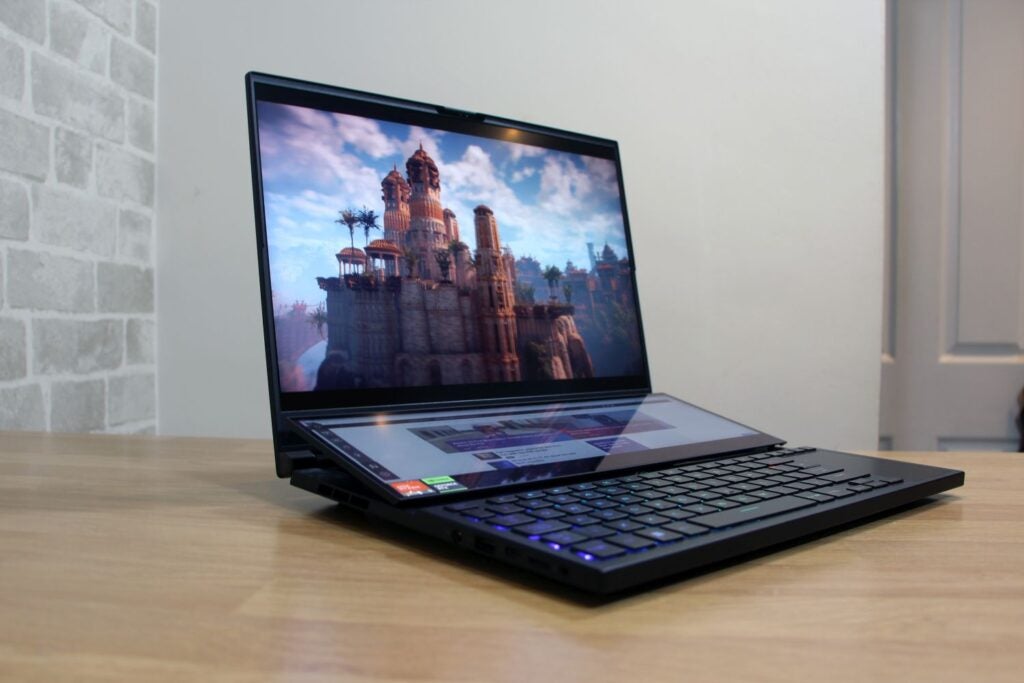
The RTX 4090 is a beast, even in Performance Mode, which doesn’t use the GPU’s full power. In Horizon Zero Dawn at Ultimate settings and 2560 x 1600, the Duo averaged 133fps – thirteen frames beyond the Scar and further ahead of the M16. In Borderlands 3, its 99fps average was a few frames behind the Scar but miles beyond the M16. It rattled through Rainbow Six Siege at 291fps – thirty frames more than the M16.
Turbo mode is even faster. Its Borderlands 3 result improved by eleven frames with that mode activated, and it gained 35fps in Rainbow Six. Use more modest performance options and you’ll still get good power: in Windows mode the Duo still played Borderlands at 96fps and still managed 119fps in Rainbow Six with Quiet mode operating.
3DMark Time Spy highlights the hierarchy. The Duo’s initial result of 16,745 is far beyond the other two Asus rigs. In Turbo mode, that score was revised to 18,647. That’s brilliant, but the MSI was even better – that huge notebook proved faster in most games and hit 20,810 in Time Spy.
The forthcoming Razer Blade 16 and Alienware m16 will run the RTX 4090 at similar power levels to the Duo, so expect a similar pace – and for this particular Asus to remain a top-tier option.
The Duo will play top single-player games without graphics compromises. Ray tracing isn’t an issue, and you’ll be able to output to 360Hz and 480Hz eSports displays alongside 4K panels and widescreens without concern.
The processor is incredible too. In Cinebench R23, the Duo’s multi-core result of 32,226 is thousands of points beyond the 27,829 scored by the Intel Core i9-13980HX in the MSI and further ahead of the more popular Core i9-13900H. Its PCMark 10 result of 9,052 is similarly dominant – hundreds of points beyond the 8,609 returned by the i9-13980HX inside the Scar.
It’s the kind of CPU that’ll motor through any content creation workload, from tough batch photo editing to 4K video work. It’ll have no issue with most workstation-level productivity apps. It’s comfortably the fastest laptop processor around, although it will be overkill for most users.
Despite the power, the Duo is a reasonable thermal performer. It only got aggressively hot on the underside, and you won’t be touching that part of the notebook anyway. There’s fan noise, but it’s no worse than most gaming laptops and easy to block if you wear a headset.
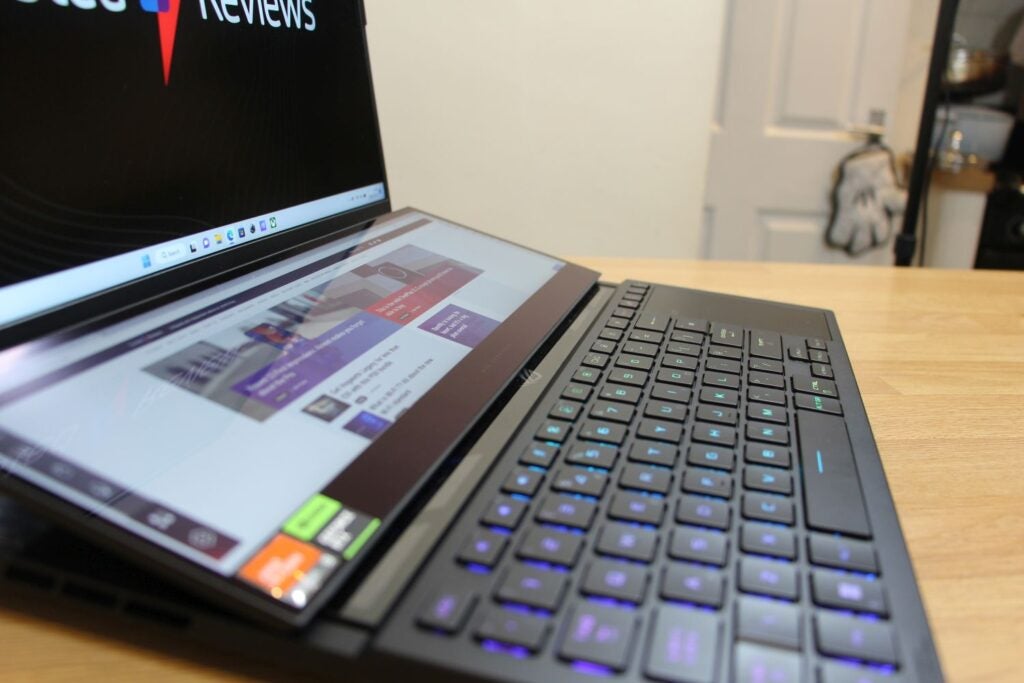
In its default Performance mode, the Duo hit about 50db, and it’s restricted to 40db in Windows mode. I’d shy away from the Turbo mode unless you’re chasing every frame because it peaks at a loud 55db. But, even then, it never approaches the ear-piercing 60db levels of the MSI Titan.
Battery Life
Don’t expect much battery life from the Asus ROG Zephyrus Duo 16, though. If you’re pushing the hardware in games or creative tools you’ll get an hour, and even with the ScreenPad deactivated and the main screen brightness lowered during modest tasks you’ll only get three or four hours of use. Most gaming laptops are better.
You’re not buying the Duo for battery life, though, and there are plenty of other areas where this notebook impresses.
Latest deals
Should you buy it?
You need two screens and record-breaking power
The pair of screens and incredible components make the Duo a formidable option for gamers, streamers and creatives – it’s a great option for versatile mobile performance.
You’d want a good keyboard and better battery life
It’s fast and those two screens impress, but the Duo is often uncomfortable to use and it won’t even get you through to lunchtime.
Final Thoughts
The Asus ROG Zephyrus Duo 16 pairs record-breaking speed with a great pair of screens, making it an exceptional option for top-line gaming and creative work. But, ergonomic compromises mean you should only buy this laptop if you’ll really appreciate its unique features.
At $3,999/£4,599/€5,599 for the RTX 4090 model and $3,499 for the RTX 4080 model, the Duo isn’t the cheapest choice. The Alienware m16 and the Asus ROG Strix Scar 16 and Zephryus M16 notebooks are all more affordable, with the Razer Blade 16 and MSI Titan GT77 costing even more.
How we test
Every gaming laptop we review goes through a series of uniform checks designed to gauge key things including build quality, performance, screen quality and battery life.
These include formal synthetic benchmarks and scripted tests, plus a series of real world checks, such as how well it runs when running a AAA game.
FAQs
Yes, the ROG Zephyrus Duo 16 is absolutely good for gaming. The high-powered components guarantee that. Some compromises are made due to its unique build though, meaning you can get better value for performance elsewhere.
The RTX 4080 model costs $3,499, with the RTX 4090 version coming in at $3,999/£4,599/€5,999.
Trusted Reviews test data
PCMark 10
Cinebench R23 multi core
3DMark Time Spy
CrystalDiskMark Read speed
Brightness (SDR)
Black level
Contrast ratio
White Visual Colour Temperature
sRGB
Adobe RGB
DCI-P3
PCMark Battery (office)
PCMark Battery (gaming)
Battery Life
Borderlands 3 frame rate (Quad HD)
Borderlands 3 frame rate (Full HD)
Horizon Zero Dawn frame rate (Quad HD)
Horizon Zero Dawn frame rate (Full HD)
Dirt Rally (Quad HD)
Dirt Rally (Full HD)
UK RRP
USA RRP
EU RRP
CPU
Manufacturer
Screen Size
Storage Capacity
Front Camera
Battery
Battery Hours
Size (Dimensions)
Weight
ASIN
Operating System
Release Date
First Reviewed Date
Model Number
Model Variants
Resolution
HDR
Refresh Rate
Ports
Audio (Power output)
GPU
RAM
Connectivity
Colours
Display Technology
Touch Screen
Convertible?
Jargon buster
Refresh Rate
The number of times the screen refreshes itself per second.
Ray Tracing
Advanced light-rendering technology that allows for more realistic lighting and shadow effects within in-game worlds.
Verdict
The Asus ROG Zephyrus Duo combines record-breaking speed with a great pair of screens, making it an exceptional option for top-line gaming and creative work. But, ergonomic compromises mean you should only buy this laptop if you appreciate its unique features.
Pros
- The world’s fastest laptop processor from AMD
- Incredible Nvidia graphics power
- Dual-screen design provides quality and versatility
- Reasonable connectivity and build quality
Cons
- Dual screens mean poor ergonomics
- Heavier and thicker than some rivals
- No Thunderbolt and no SD card reader
- Pricier than some competitors
Availability
- UKRRP: £4599
- USARRP: $3999
- EuropeRRP: €5599
Introduction
Some companies aren’t shy about pushing design boundaries, and the dual-screen ROG Zephyrus Duo is another head-turner from Asus.
This is the kind of innovation people will appreciate, and it’s not just about games. Asus reckons it’ll prove popular with streamers and creatives who want more space for timelines and communication tools.
There’s no power shortage, thanks to an Nvidia GeForce RTX 4090 and flagship AMD processor. But, there’s no shortage of high prices here either, with this range-topping Zephyrus (GX650PY-NM010W) costing $3999/£4599/€5599.
Asus rigs like the Strix Scar 16 have already arrived, the MSI Titan GT77 is a powerhouse, and forthcoming Alienware and Razer laptops will aim for our best gaming laptops guide.
Design and Keyboard
- Often uncomfortable to use
- Decent connectivity, but no Thunderbolt
- Heavier and thicker than many rivals
Unsurprisingly, the second display – dubbed the ScreenPad Plus – dominates every aspect of the Duo. Open the lid and a mechanism lifts the ScreenPad to an angle of thirteen degrees, which improves cooling and viewing angles.
It looks cool and futuristic. There’s an iridescent slash on the lid and RGB-filled glass between the ScreenPad and keyboard that add to the vibe.

Build quality is consistently excellent, and the screen mechanisms work smoothly. You’ll only want extra protection for this laptop to protect its looks.
At 2.7kg in weight, 30mm thick and 266mm deep, it’s heavier than the Asus ROG Strix Scar 16 and Zephyrus M16 and larger than the forthcoming Razer Blade 16. The MSI Titan GT77 and Alienware m16 are even bigger, though.
The second screen doesn’t just add bulk, its inclusion forces the keyboard to the front of the notebook and makes the layout cramped. There’s a single-height Return key, small cursor buttons and no number pad. There’s no wristrest, and Asus’s rubberized version doesn’t attach to the laptop, so it’s easy to knock out of position.
The trackpad has an awkward number pad overlay, and the pad is extremely narrow. It’s not intuitive for gaming or creative work.

It’s a shame, because the keyboard offers good quality, with per-key RGB LED lighting, 1.7mm of travel and a snappy, consistent typing action that’s great for work and games. You’ll only get a better feel by opting for a mechanical alternative, like the MSI Titan GT77 or the Alienware’s optional CherryMX upgrade. It’s just a shame that everything’s so squeezed.
The Asus has two USB 3.2 Gen 2 ports and two USB-C connectors with DisplayPort and power delivery. It’s also got an HDMI 2.1 port and a microSD card slot. Internally, there’s 2.5Gbps Ethernet, Wi-Fi 6E and Bluetooth 5.3.
Unfortunately, the rig’s AMD processor means no Thunderbolt, and there’s no full-size card reader. Razer and Alienware laptops offer the latter, and you’ll find Thunderbolt on everything with an Intel CPU.
The Duo has a 1080p Windows Hello webcam but doesn’t have a privacy shutter. There’s no fingerprint reader. The Duo offers pairs of M.2 and memory slots, but getting inside the laptop is extremely difficult.
Screen
- Market-leading, high-resolution Mini LED
- Second screen is an ideal home for secondary apps
- Punchy and clear speakers
The main panel of the Asus ROG Zephyrus Duo 16 is a 16:10 Mini LED display with a 2560 x 1600 resolution. Asus claims a maximum brightness of 1,100 nits, and the screen has 1,024 dimming zones. The 240Hz refresh rate and 3ms response time will satisfy most gamers.
The ScreenPad is a 14 inch panel with a 3840 x 1100 resolution designed to retain size and clarity when apps move between the displays. It’s not Mini LED, but it’s a Gorilla Glass touchscreen with stylus support and IPS technology.

That secondary screen is ideal for streamers and gamers who need space for comms and configuration tools as well as creatives who need room for timelines or extra apps. It’s not for everyone, but it’s a useful addition.
It’s easy to use, too. The Asus Screen Xpert app allows users to create custom layouts and groups of apps, and the Asus Control Center has dedicated dials and buttons for Adobe’s creative apps.
The main display is brilliant. In HDR mode, the panel attains a 1,047-nit brightness level. Its dimming zones deliver genuine punch and nuance in HDR content. In SDR mode, it tops out at a mighty 752 nits. The low black point of 0.05 nits means contrast levels of about 15,000:1, so you get stunning vibrancy and punch in any gaming or creative app.
The Delta E of 1.52 means accurate colours, and the screen produced 99.9% of the sRGB gamut and 98.5% of the DCI-P3 space – so it’ll handle any game or media situation. A minor issue is the Adobe RGB coverage level of 89.2%, which isn’t quite high enough for demanding creatives.

The ScreenPad’s maximum brightness of 397 nits is alright for indoor use and it displayed 96.2% of the sRGB space with a Delta E of 1.8. It’s fine, even if it doesn’t have the breadth for creative work.
Combine the two screens and you’ve got a brilliant screen setup. The vibrant, detailed main display makes games and films look fantastic. It’s got accuracy for most work tasks, too. That second screen is a capable option for secondary tools.
No rivals compete in terms of quality – the ROG Strix Scar is close – so you’ll only want to look elsewhere for different attributes. The Blade 16 has a 3840 x 2400 panel at 120Hz that can switch to a 1920 x 1200/240Hz mode and the Alienware m16 has a 480Hz upgrade for eSports.
Games and media won’t just look good on this laptop – the six speakers mean they’ll sound good, too. The Duo’s audio is loud, punchy and clear, with ample detail. There could be a bit more bass, but that’s a minor complaint.
Performance
- AMD Ryzen 9 7945HX is the fastest laptop CPU around
- RTX 4090 offers incredible gaming speed
- Strong thermals, but poor battery life
The Nvidia GeForce RTX 4090 is a flagship mobile GPU with 9,728 shader units and 16GB of memory. It operates near Nvidia’s 175W peak power level. AMD’s Ryzen 9 7945HX has sixteen multi-threaded Zen 4 cores and a 5.4GHz boost speed.
There’s 32GB of dual-channel DDR5 memory and a 2TB SSD with excellent read and write speeds of 7,114 MB/s and 5,917 MB/s.

The RTX 4090 is a beast, even in Performance Mode, which doesn’t use the GPU’s full power. In Horizon Zero Dawn at Ultimate settings and 2560 x 1600, the Duo averaged 133fps – thirteen frames beyond the Scar and further ahead of the M16. In Borderlands 3, its 99fps average was a few frames behind the Scar but miles beyond the M16. It rattled through Rainbow Six Siege at 291fps – thirty frames more than the M16.
Turbo mode is even faster. Its Borderlands 3 result improved by eleven frames with that mode activated, and it gained 35fps in Rainbow Six. Use more modest performance options and you’ll still get good power: in Windows mode the Duo still played Borderlands at 96fps and still managed 119fps in Rainbow Six with Quiet mode operating.
3DMark Time Spy highlights the hierarchy. The Duo’s initial result of 16,745 is far beyond the other two Asus rigs. In Turbo mode, that score was revised to 18,647. That’s brilliant, but the MSI was even better – that huge notebook proved faster in most games and hit 20,810 in Time Spy.
The forthcoming Razer Blade 16 and Alienware m16 will run the RTX 4090 at similar power levels to the Duo, so expect a similar pace – and for this particular Asus to remain a top-tier option.
The Duo will play top single-player games without graphics compromises. Ray tracing isn’t an issue, and you’ll be able to output to 360Hz and 480Hz eSports displays alongside 4K panels and widescreens without concern.
The processor is incredible too. In Cinebench R23, the Duo’s multi-core result of 32,226 is thousands of points beyond the 27,829 scored by the Intel Core i9-13980HX in the MSI and further ahead of the more popular Core i9-13900H. Its PCMark 10 result of 9,052 is similarly dominant – hundreds of points beyond the 8,609 returned by the i9-13980HX inside the Scar.
It’s the kind of CPU that’ll motor through any content creation workload, from tough batch photo editing to 4K video work. It’ll have no issue with most workstation-level productivity apps. It’s comfortably the fastest laptop processor around, although it will be overkill for most users.
Despite the power, the Duo is a reasonable thermal performer. It only got aggressively hot on the underside, and you won’t be touching that part of the notebook anyway. There’s fan noise, but it’s no worse than most gaming laptops and easy to block if you wear a headset.

In its default Performance mode, the Duo hit about 50db, and it’s restricted to 40db in Windows mode. I’d shy away from the Turbo mode unless you’re chasing every frame because it peaks at a loud 55db. But, even then, it never approaches the ear-piercing 60db levels of the MSI Titan.
Battery Life
Don’t expect much battery life from the Asus ROG Zephyrus Duo 16, though. If you’re pushing the hardware in games or creative tools you’ll get an hour, and even with the ScreenPad deactivated and the main screen brightness lowered during modest tasks you’ll only get three or four hours of use. Most gaming laptops are better.
You’re not buying the Duo for battery life, though, and there are plenty of other areas where this notebook impresses.
Latest deals
Should you buy it?
You need two screens and record-breaking power
The pair of screens and incredible components make the Duo a formidable option for gamers, streamers and creatives – it’s a great option for versatile mobile performance.
You’d want a good keyboard and better battery life
It’s fast and those two screens impress, but the Duo is often uncomfortable to use and it won’t even get you through to lunchtime.
Final Thoughts
The Asus ROG Zephyrus Duo 16 pairs record-breaking speed with a great pair of screens, making it an exceptional option for top-line gaming and creative work. But, ergonomic compromises mean you should only buy this laptop if you’ll really appreciate its unique features.
At $3,999/£4,599/€5,599 for the RTX 4090 model and $3,499 for the RTX 4080 model, the Duo isn’t the cheapest choice. The Alienware m16 and the Asus ROG Strix Scar 16 and Zephryus M16 notebooks are all more affordable, with the Razer Blade 16 and MSI Titan GT77 costing even more.
How we test
Every gaming laptop we review goes through a series of uniform checks designed to gauge key things including build quality, performance, screen quality and battery life.
These include formal synthetic benchmarks and scripted tests, plus a series of real world checks, such as how well it runs when running a AAA game.
FAQs
Yes, the ROG Zephyrus Duo 16 is absolutely good for gaming. The high-powered components guarantee that. Some compromises are made due to its unique build though, meaning you can get better value for performance elsewhere.
The RTX 4080 model costs $3,499, with the RTX 4090 version coming in at $3,999/£4,599/€5,999.
Trusted Reviews test data
PCMark 10
Cinebench R23 multi core
3DMark Time Spy
CrystalDiskMark Read speed
Brightness (SDR)
Black level
Contrast ratio
White Visual Colour Temperature
sRGB
Adobe RGB
DCI-P3
PCMark Battery (office)
PCMark Battery (gaming)
Battery Life
Borderlands 3 frame rate (Quad HD)
Borderlands 3 frame rate (Full HD)
Horizon Zero Dawn frame rate (Quad HD)
Horizon Zero Dawn frame rate (Full HD)
Dirt Rally (Quad HD)
Dirt Rally (Full HD)
UK RRP
USA RRP
EU RRP
CPU
Manufacturer
Screen Size
Storage Capacity
Front Camera
Battery
Battery Hours
Size (Dimensions)
Weight
ASIN
Operating System
Release Date
First Reviewed Date
Model Number
Model Variants
Resolution
HDR
Refresh Rate
Ports
Audio (Power output)
GPU
RAM
Connectivity
Colours
Display Technology
Touch Screen
Convertible?
Jargon buster
Refresh Rate
The number of times the screen refreshes itself per second.
Ray Tracing
Advanced light-rendering technology that allows for more realistic lighting and shadow effects within in-game worlds.

























